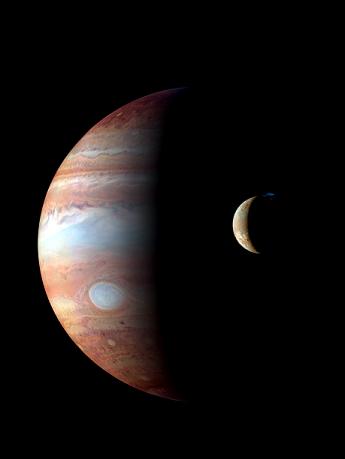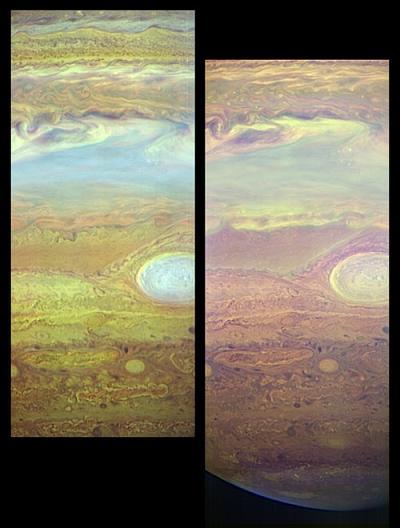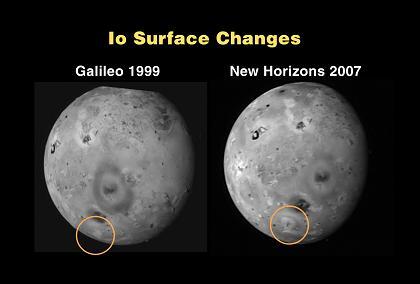The journey of the New Horizons spacecraft allowed it to take a closer look at the planet Jupiter - and discover that it has changed

Photo: Montage of Tzedek and Iyo.
New Horizons flew past Jupiter on February 28, harnessing the planet's gravitational field to increase its speed and shave three years off its trip to Pluto. New Horizons is already the eighth spacecraft to visit Jupiter, but the combination of advanced technology, trajectory and correct timing allowed it to explore details that no other probe had seen before. Lightning near the planet's poles, the life cycle of fresh ammonia clouds, boulder-sized chunks speeding through the star's pale rings, volcanic eruptions on the moon Io, and even the orbit of charged particles cruising the star's long magnetic tail - a previously unexplored region. The New Horizons uncovered and documented all of these.
"We didn't imagine that the encounter with Jupiter would be so successful," says New Horizons principal investigator Alan Stern from NASA headquarters in Washington. "It proved the capabilities of our spacecraft, and allowed it to enter the orbit where it will reach Pluto in 2015. But beyond that, it gave us the possibility to place sophisticated instruments in areas around Jupiter that other spacecraft could not reach, and provide important information that contributes a lot to our understanding of The largest planet in the solar system, its moons, rings and atmosphere.
The New Horizons team presented the latest and most detailed analyzes of the data on October 10, 2007, at the American Astronomical Society's meeting for planetary sciences in Orlando, Florida. The information was also published in a special supplement to Science magazine on October 12. The supplement contains nine technical articles written by members of the New Horizons team and other authors with whom they have worked collaboratively.
New Horizons' seven science instruments recorded more than 700 separate observations of the Solar System between January and June. Most of the observations were made in the eight days when the spacecraft was closest to Jupiter. "We carefully selected observations that would complement previous missions, so we could focus on important science issues that needed further investigation," says New Horizons Jupiter Science Team Leader Jeff Moore at NASA's Ames Research Center in California. "The system of Jupiter is constantly changing, and New Horizons was in the right place at the right time and was able to see some exciting developments."
One of the most fascinating successes was the investigation of the weather on Jupiter. The instruments on board New Horizons studied the atmosphere of Jupiter in visible, infrared and ultraviolet light frequencies, in an attempt to obtain information on the composition of the clouds and their structures. The devices photographed clouds formed from ammonia flickering from the lower atmosphere, and lightning strikes in the polar regions, which were created as a result of heat. Until now, lightning has been observed at the poles only on Earth. The lightning proves that heat passes through the water clouds throughout the length and breadth of Jupiter. The instruments measured with considerable precision the size and speed of the 'waves' that travel the entire length of the planet and indicate a fierce storm below the surface of the clouds. In addition, New Horizons took close-up images of the 'Little Red Spot' - a young storm in the stages of development. It reaches about half the size of the 'Great Red Spot' of Jupiter, and its diameter is 70% of the diameter of the Earth. The images will help to get new information about the dynamics of the storms.
Thanks to the wide variety of lighting conditions and shooting angles made possible by the spacecraft, New Horizons also captured the clearest images to date of Jupiter's thin ring system. Scientists have located chunks of debris in the images that may indicate a recent collision within the rings, or a more exotic scenario. Movies made from the New Horizons images offer an unprecedented look into the dynamics of the rings, along with the tiny inner moons - Metis and Adrastea - chasing the material around the rings. Although a search was made for smaller moons within the rings, and for possible new sources of dust, no bodies larger than one kilometer across were discovered.
Of Jupiter's four largest moons, the spacecraft's study focused on Io, the closest to Jupiter. Io's active volcanoes eject tons of material into Jupiter's magnetosphere, and beyond. New Horizons located 11 volcanic crowns of various sizes, three of which were observed for the first time. One of the 11 - originating from a spectacular eruption at an altitude of 400 kilometers, from the Tavashtar volcano - offered an unprecedented opportunity to follow the structure of the corona and its movement, as it vaporized at high altitude and fell back to the surface of the moon. In addition, New Horizons located Venus in infrared from at least 36 volcanoes on Io, and measured lava temperatures of up to 1040 degrees Celsius. This temperature is similar to that measured in many volcanoes on Earth.
The map of Io's surface, as obtained from New Horizons, confirms the moon's place as the most active body in the solar system. The map shows more than 20 geological changes that have accumulated since Galileo orbited Jupiter in 2001, and last surveyed Io. The distant photographers continued to take pictures of Io even in the dark under the shadow of Jupiter, and noticed mysterious bright gas clouds above dozens of volcanoes. Scientists suspect that this gas helps fill Io's atmosphere.
New Horizons' flyby down Jupiter's magnetosphere provided its first look at the vast region dominated by the planet's strong magnetic field. The New Horizons particle detectors focused specifically on the streams of charged particles that flow millions of miles away from the giant planet. Thanks to these detectors, it was discovered that tons of material from the volcanoes of Io are slowly moving down Jupiter's tail in large, compact clumps. The New Horizons scientists analyze the observed variations in the particle fluxes over a wide range of energies, and study how the volcanic gases from Io become ionized and are then captured and excited by Jupiter's magnetic field. Their time in the Jupiter region ends when, finally, they are ejected from the Jupiter system.
New Horizons was designed, built and operated by the Applied Physics Laboratory at Johns Hopkins University. It was launched from Cape Canaveral Air Force Base in Florida in January 2006. It took the spacecraft only 13 months to reach Jupiter, and it is the fastest spacecraft ever launched. New Horizons is currently halfway between Jupiter and Saturn, and at a distance of more than 1.19 billion kilometers from Earth. It will pass Pluto and its moons in July 2015 and from there it will continue to advance into the Kuiper Belt on its icy rocks.
New Horizons is the first mission under NASA's New Frontiers program. The program singles out research and discovery projects for spacecraft from the Medium group (weighing 1.5 to 3 tons). Stern heads the mission and heads the science team as principal investigator. The Applied Physics Laboratory implements the mission for NASA's Space Mission Management. The task force also includes Southwest Research Institute, NASA Goddard Space Flight Center, NASA Rocket Propulsion Laboratory, Stanford University, Kinetics Inc. (navigation team), Lockheed Martin Corporation, University of Colorado, US Department of Energy B and a number of other companies, NASA centers and university partnerships.
Free source: http://pluto.jhuapl.edu/news_center/news/100907.htm
Attached movie: Ammonia clouds on Jupiter
Image 2: The changing surface of an island.

Image 3: Images of a storm in Jupiter's atmosphere, taken through infrared sensors.


12 תגובות
Say -
I'm not sure you can't say that rocks accelerate through the star's rings, but I agree about everything else.
Thanks for the constructive review. I took note, and will try not to repeat the mistakes in the future.
Nice article and I agree with the sentiments expressed by the commenters
but
Rocks fly or move through the star's rings, not "accelerate"
Clouds thicken, "don't get hungry"
We photograph, not "take pictures"
And the pictures are taken using, not "through" infrared sensors
Thanks
Doctor Lifschitz -
I would love to hear what your evidence is for such blanket claims.
Everything was brilliantly driven by NASA that releases beautiful computer simulations and you believe!
Thanking, thanking, and also leaving,
Please, have mercy!
Sabdarmish Yehuda
The phrase is "confess and leave - they will have mercy", but not bad, it's good to see that more people are using phrases from the Bible.
Every time I read articles like this it makes me want to fly something into space or even land a vehicle on another planet.
And I'm not kidding, I intend to do this in the future.
To Roy Cezana
On this it is said: - Thanks and repeats, Yeruham!
And so you have no doubt, the article was ten.
Sabdarmish Yehuda
exciting
Oops.
Originally, a medium group spacecraft weighed between 3000 and 6000 pounds. One pound is around 450 grams.
The devil wanted, and I converted pounds to 450 kilograms instead of grams.
Thanks for setting me up for the mistake.
my people -
I'm glad you enjoyed the article. I highly recommend going to the link at the end, which contains many more spectacular photos from the mission.
interesting.
A "small" mistake by the translator Roy Tsezana. Spacecraft from the Medium group do not weigh one and a half million to three million kg. We will be more modest here. I estimate that it is a thousandth of that, 1.5-3 tons.
Have a good weekend
Sabdarmish Yehuda
Yo, what a dream article - really.
I read it and didn't want it to end. So fascinating and amazing to see these pictures. To think that the spacecraft we sent is already more than a billion kilometers from the earth and that if everything goes well in a few years it will reach amazing places and photograph events that have never been seen before. It's amazing and it sounds like a dream. I developed a great appetite to run to Wikipedia and look for the planets in our solar system. It is interesting how much we really know about all the small moons that orbit around the gas giants and what really happens under the gaseous atmosphere of the planets. Is it possible that you will still find hard ground there that we can't see? Terrestrial or marine nuclear? And as you go deeper inside, to the center, is it possible there a place where the temperatures (because of the pressure) are in the area between minus one hundred and plus one hundred degrees Celsius? And if so, it is quite possible that organic compounds or maybe even strange forms of life will be found there.
An amazing and fascinating article and I hope very much (very - very much) that there will be many more like this. Long and detailed with pictures and explanations - like in children's books. Real fun.